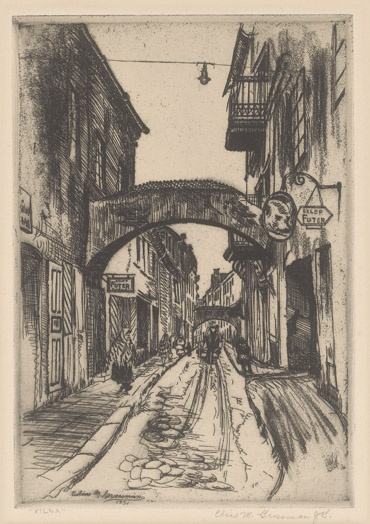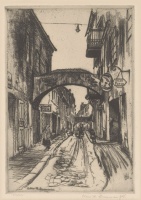
J. Kliačka Street in Vilnius
| Author: |
Elias Grossman (1898–1947)  |
| Created: | 1931 |
| Material: | paper |
| Technique: | etching |
| Dimensions: | 25 × 17.20 cm |
| Signature: | bottom left: Ealias M. Grossman / 1931 / „VILNA“, bottom right: Elias M. Grossman, signature |
Inspired by the Jewish Ghetto, Elias Mandel Grossman (1898–1947) made a picture of the famous street in the Old Town with its arches. The picture is made up of sharp and temperamental lines. The artist noticed various details of local colour: the dirty cobbled street, a passer-by wrapped up in a shawl, and a horse-drawn cart. His attention was drawn by a Polish sign announcing ‘Sklep futer’ (fur-coat shop), with the head of a fox painted on it. Primitive signs like this had already disappeared in the West, and so it fascinated artists between the wars. It reminded Grossman of his native Kobryn. The picture of the street is accurate, but it is a mirror-image etching made from a sketch.
Text author Laima Laučkaitė
Vilnius, the Jerusalem of Lithuania. The wisdom and light spread by the Vilna Gaon in the 18th century helped to earn Vilnius the title of ‘Jerusalem of Lithuania’. Religious Jews and scholars came to Vilnius from all over the world to listen to the teachings of the Vilna Gaon, and the city became an important centre of religion, learning and Yiddish literature. The poet David Einhorn wrote: ‘People would go to Warsaw, Odessa or Kiyv in search of work. There was no chance of earning a living in Vilnius. It was a place where they went to study.’ The image of Vilnius as the Jerusalem of Lithuania emerged in art in the early 20th century.
The etchings by Ber Zalkind in the collection of postcards ‘The Vilnius Jewish Ghetto’, published in 1928 and aimed at visitors to Vilnius, contributed greatly to the spread of the myth of the Jerusalem of Lithuania. The artist conveyed accurately the aura of the Jewish city, depicting the main landmarks: the Great Synagogue and the Strashun Library, Stiklių and Mėsinių streets, and the alleys and courtyards of the Jewish quarter. A painting by Mojżesz Lejbowski gives us a glimpse of the city through the Gates of Dawn. Elias Mandel Grossman, who emigrated to America as a child and travelled extensively in Europe before 1940, visited Vilnius in 1931. His etching J. Kliačka Street in Vilnius (now Mark Antokolsky Street) depicts the famous street in the Jewish quarter in great detail, with its two arches, balconies and shutters, shop signs, women in scarves, and a horse pulling a cart. Interestingly, the etching, which is based on a sketch, switches round the left and right sides of the street.
Text author Vilma Gradinskaitė
Source: Law firm Valiunas Ellex art album VILNIUS. TOPOPHILIA I (2014). Compiler and author Laima Laučkaitė, STORIES OF LITVAK ART (2023). Compiler and author Vilma GradinskaitėExpositions: “Vilnius. Topophilia. Views of Vilnius from the collection of the law firm Ellex Valiunas”, 5 October – 26 November 2017, National Gallery of Art, Vilnius. Curator Laima Laučkaitė: “Lithuania in Litvak Arts”, 6 June – 16 November, Tolerance Centre of the Vilna Gaon State Jewish Museum (Naugarduko St. 10/2, Vilnius). Curator Vilma Gradinskaitė







